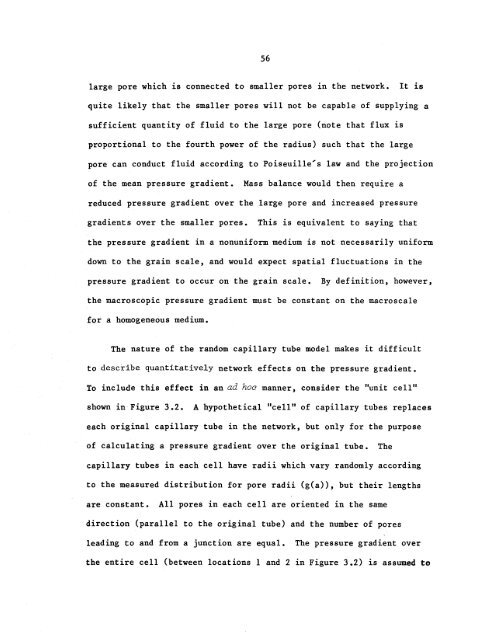longitudinal dispersion in nonuniform isotropic porous media
longitudinal dispersion in nonuniform isotropic porous media
longitudinal dispersion in nonuniform isotropic porous media
Create successful ePaper yourself
Turn your PDF publications into a flip-book with our unique Google optimized e-Paper software.
large pore which is connected to smaller pores <strong>in</strong> the network. It is<br />
quite likely that the smaller pores will not be capable of supply<strong>in</strong>g a<br />
sufficient quantity of fluid to the large pore (note that flux is<br />
proportional to the fourth power of the radius) such that the large<br />
56<br />
pore can conduct fluid accord<strong>in</strong>g to Poiseuille's law and the projection<br />
of the mean pressure gradient. Mass balance would then require a<br />
reduced pressure gradient over the large pore and <strong>in</strong>creased pressure<br />
gradients over the smaller pores. This is equivalent to say<strong>in</strong>g that<br />
the pressure gradient <strong>in</strong> a <strong>nonuniform</strong> medium is not necessarily uniform<br />
down to the gra<strong>in</strong> scale, and would expect spatial fluctuations <strong>in</strong> the<br />
pressure gradient to occur on the gra<strong>in</strong> scale. By def<strong>in</strong>ition, however,<br />
the macroscopic pressure gradient must be constant on the macro scale<br />
for a homogeneous medium.<br />
The nature of the random capillary tube model makes it difficult<br />
to describe quantitatively network effects on the pressure gradient.<br />
To <strong>in</strong>clude this effect <strong>in</strong> an ad hoc manner, consider the "unit cell"<br />
shown <strong>in</strong> Figure 3.2. A hypothetical "cell" of capillary tubes replaces<br />
each orig<strong>in</strong>al capillary tube <strong>in</strong> the network, but only for the purpose<br />
of calculat<strong>in</strong>g a pressure gradient over the orig<strong>in</strong>al tube. The<br />
capillary tubes <strong>in</strong> each cell have radii which vary randomly accord<strong>in</strong>g<br />
to the measured distribution for pore radii (g(a», but their lengths<br />
are constant. All pores <strong>in</strong> each cell are oriented <strong>in</strong> the same<br />
direction (parallel to the orig<strong>in</strong>al tube) and the number of pores<br />
lead<strong>in</strong>g to and from a junction are equal. The pressure gradient over<br />
the entire cell (between locations 1 and 2 <strong>in</strong> Figure 3.2) is assumed to

















